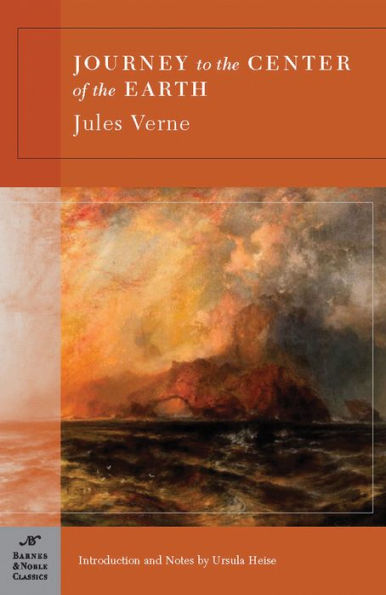Read an Excerpt
From Ursula Heise’s Introduction to Journey to the Center of the Earth
Traveling to the center of the Earth would involve a downward trip of about 4,000 miles that would cut through the Earth’s crust and its mostly solid, rocky mantle into a liquid core of iron alloy, then end at a solid inner core of iron and nickel. Pressure and temperature would rise with increasing depth, and temperatures would reach about 10,300 degrees Fahrenheit at the Earth’s center—hardly a climate that many geo-tourists would enjoy! Much of this knowledge about the geophysical structure of the Earth was acquired in the course of the twentieth century, long after Jules Verne published Journey to the Center of the Earth. In 1864, when the book appeared, different hypotheses about the nature of the Earth competed with each other. Even then, though, in light of any of the contemporary scientific theories, a journey to the Earth’s core belonged to the realm of the fantastic. Why then did Verne, who was intensely interested in the science and technology of his day, choose this idea as the founding assumption of what was to become one of his most famous novels? And why is this journey undertaken not by a dreamer or a madman, but by a hard-core scientist, a professor of mineralogy and geology who is thoroughly familiar with the scientific debates of his time?
For a reader who first encounters Journey to the Center of the Earth at the beginning of the twenty-first century, the enthusiasm of Professor Otto Lidenbrock, his nephew Axel, and even Lidenbrock’s goddaughter Graüben for mineralogical specimens and geological theories may seem nothing short of eccentric. After Alfred Wegener’s theory of continental drift—originally proposed in the 1920s—had been generally accepted in the 1960s, geology disappeared from public awareness as a science that could bring about exciting new discoveries and theories. But in the middle of the nineteenth century, geology was a brand-new branch of knowledge rife with the opposing theories and opinions of some of the best minds of the day. Far from being an arcane branch of scientific knowledge of mostly academic interest, it touched upon the most basic questions of the origin of life and human beings and the nature of the very soil they walk upon. Not just scholars but public and religious authorities believed they had a vital stake in the outcome of geological controversies.
As a scientific discipline, geology had in fact only come into being in the first half of the nineteenth century. Before that, mineralogists had been just about the only scientists to study the inanimate environment, conducting their investigation of the Earth most frequently in the context of French and German mining schools. Their study consisted of a mix of natural philosophy, theology, and the beginnings of empirical observation, without the benefit of an established academic framework. Abraham Gottlob Werner, a German professor at the Mining School of Freiberg in the late eighteenth century, combined the study of rock formations with the biblical account of Genesis. The Scottish naturalist, chemist, and geologist James Hutton opposed Werner’s theories and grounded his own account of the development of the Earth on observable processes and on the principle of uniformitarianism—that is, the idea that the processes that had gone into the shaping of the Earth over immensely long periods of time had not fundamentally changed and could still account for geological development. Hutton’s work was followed by that of Scottish geologist Charles Lyell, whose classic book Principles of Geology, published in 1830, laid down the foundations of a new, empirically based science of the Earth.
But the Earth is so vast and all-encompassing that it often appeared complicated to infer its general operating principles from the processess observable in one particular place. Indeed, huge areas of geology—the 70 percent of the Earth’s surface that is under water, as well as its interior—are simply inaccessible to direct human observation. (Lyell once joked that an amphibious observer who could inhabit both land and sea would be a more suitable geologist than a human being.) For these reasons, divergent theories about the nature of the Earth continued to rage throughout the nineteenth century. While some scholars argued that the interior of the Earth had to be mostly liquid, with the solid ground a mere thin crust not unlike ice on lake water, others replied that on mathematical grounds the Earth could not be anything but for the most part solid. The age of the Earth was similarly subject to vastly divergent estimations, and this issue became part of the violent controversy over Darwin’s theory of evolution in the 1850s and 1860s. Biological evolution occurs over immense periods of time, and in general, the development of the physical structure of the Earth over hundreds of thousands or even millions of years contradicts creationist accounts of a much shorter time span for the origins of the Earth.
In Verne’s day, therefore, geological theories about the origin and gradual shaping of the Earth, along with biological insights into the evolution of life, were what genetic engineering and nanotechnology are for us today: innovative and exciting areas of scientific research that have a profound bearing on the way we think about our own identity and experience our everyday lives. Verne’s familiarity with these debates shows up in every chapter of Journey to the Center of the Earth, which abounds in references to the leading scientific minds of his day, from naturalists and geologists such as Georges Cuvier to explorers such as Alexander von Humboldt and archaeologists such as Jacques Boucher de Perthes. Caught up in the evolving plot, a contemporary reader’s attention might easily slide over such references unawares. But their presence is the equivalent of mentions of James Watson and Francis Crick, Stephen Hawking, or Bill Gates in a novel written today.









